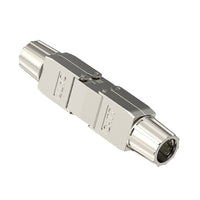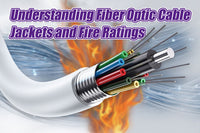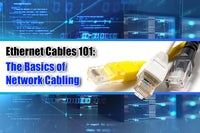Ethernet cables are not always installed in indoor environments. You should consider Ethernet cable jacket ratings for different scenarios, such as plenum and outdoor applications. The National Electric Code (NEC) specifies different fire ratings, of which the most typical grades are CM (CMG), CMR, CMP, and CMX. Understanding these ratings is of great importance for individual safety and network performance. The below content will provide an overview of cable fire ratings and hope this can help you a lot.
Ethernet Cable Fire Ratings
According to NEC's cable fire rating guidelines, there are different cable ratings. Common Ethernet cable fire ratings are CM, CMR, CMP, and CMX, based on their abilities to resist fire and heat. These Ethernet cable ratings actually indicate the fire resistance of cable jackets.
CM Cables / General Purpose Cables
Communications Multipurpose (CM) cables, also known as general purpose cables, are the most common Ethernet cables used for home or commercial buildings. The CM rating is specified by the industry burn test standard UL 1581 and CSA FT1, which is the basic jacket rating. The jackets of CM cables are usually made of polyvinyl chloride (PVC) material, meaning that they have no fire protection. CM cables are very cost-effective, so they are widely used in commercial and residential applications. But CM cables are often used for short-distance network connections.
CMR / Riser Cables
CMR cable refers to “Communications Multipurpose Cable, Riser”, which is also known as Riser-rated cable or Riser cable. The CMR rating is a jacket rating defined by standards UL 1666 and CSA FT4. CMR cables feature outer jackets that are also made of PVC but with insulation layers made of Teflon. Compared to common CM cables, CMR cables boast thicker cable jackets and provide flame resistance. However once exposed to fire, these cables will release toxic gases. CMR cables are commonly found in vertical cabling to prevent fire from spreading, such as risers and shafts between floors in buildings. In fact, they can be used anywhere in a building except the plenum.
CMP / Plenum Cables
CMP is short for “Communications Multipurpose Cable, Plenum”. The plenum refers to the area that handles air, for example, HVAC systems are often installed inside the plenum. Plenum cables undergo strict testing and it is defined by the NEC as the highest fire rating for Ethernet cable jackets. CMP cables are typically made of fluorinated ethylene propylene (FEP) that emits little smoke. Plenum cables are designed to prevent fire spread and emit little to no toxic gases. Though CMP cables can be used for most applications, they are usually confined to ventilation spaces due to their high cost.
CMX / Outdoor Cables
CMX stands for Communications Limited Purpose, specified by the UL 1581 VW-1 test. CMX cable has the lowest fire rating among these cables. Made of Linear Low-Density Polyethylene (LLDPE). CMX cables are resistant to sunlight, moisture, and extreme temperature change, making them suitable for both indoor and outdoor applications. They are often installed in the open air or in direct burial.

CM vs. CMR vs. CMP vs. CMX: How to Choose the Right One?
To ensure maximum cable performance and minimize the cost, you should select the suitable cable for specific applications. For example, CM cables for usually in the form of Ethernet patch cables for short-distance network connectivity. Here is a guideline for you.
Ethernet cables with fire-rated jackets are usually used for indoor uses, such as CM, CMR, and CMP cables. CMX, with the least fire resistance, is generally designed for outdoor uses.
If you want to find an Ethernet cable used to directly connect your computer and router in the same room or on the same floor, a CM patch cable is your prior choice. CM cables can be used for general applications in residential buildings. CMR cables are recommended for vertical cabling in walls or between floors. If you run cable through air plenum areas for commercial uses, CMP cables are your preferred choice.
Another factor you should consider is the installation cost. Though CMP cables can be installed in any area, the high cost limits their uses. CMP cables are the most expensive among these cables, while CM cables are the most cost-effective type. Selecting the proper cable jacket is crucial for the best cable performance.
|
CM |
CMR |
CMP |
CMX |
|
|
General Purpose Uses |
✅ |
✅ |
✅ |
✅ |
|
Riser (Non-plenum Spaces) |
❌ |
✅ |
✅ |
❌ |
|
In-wall Uses |
❌ |
✅ |
✅ |
❌ |
|
Plenum Spaces |
❌ |
❌ |
✅ |
❌ |
|
Outdoor Applications/ Direct Burial |
❌ |
❌ |
❌ |
✅ |
|
Fire Ratings |
CMP>CMR>CM>CMX |
|||
Notes: The above diagram only offers general information. Knowing more information about specific applications, please consult manufacturers or network technicians for guidance.
PVC vs. LSZH
When talking about Ethernet cables, PVC and LSZH are often mentioned. What do they refer to? These two words mean the chemical components used in the production of Ethernet cables.
- PVC: PVC is an abbreviation of Polyvinyl Chloride, and it is a low-cost and flexible material often used for low-voltage wiring. PVC can emit toxic gases when burning, so it is not suitable for plenum applications.
- LSZH: LSZH, also called Low Smoke Zero Halogen, as its name implies, emits little smoke and toxic halogen gas. LSZH cables have higher flame resistance but are more expensive than PVC materials. LSZH has a higher standard than Plenum, which is often used in Europe.
Notes: Fire-rated vs. Flame-retardant cables
Fire-rated cables can continue to work for a specific time in the event of a fire. The 2-hour fire-rated cable can maintain the circuit integrity and continue to work under specific conditions. Flame-retardant cables can prevent the fire from spreading to new areas. They are not as strong as fire-rated cables.
Conclusion
Ethernet cables have various fire ratings and can be designed for different applications. Understanding Ethernet cable jacket fire ratings helps you ensure cable performance and safety. If you’re not sure what to choose, you can consult the cable manufacturers or professionals.
For more information on this topic, you can keep up on our blogs. While VCELINK offers general and basic information for our customers and other visitors to the website, it’s not professional advice.




Be the first one to comment.
Leave a comment